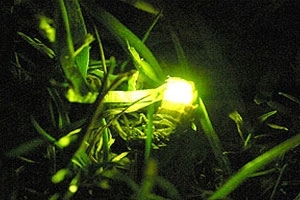Glow worm (Lampyris noctiluca)
 Why was the glow worm unhappy? Because her children were not that bright!
Why was the glow worm unhappy? Because her children were not that bright!
This would indeed make the flightless female glow worm sad as the brightness of her offspring’s light, situated in the last three segments of the abdomen, is important in attracting flying males to mate with, thereby ensuring the continuation of the species.
Glow worms are in fact beetles and at the adult stage look a little like long woodlice. The female is twice the size of the male and can measure up to 25mm in length. When she is ready to mate in June and July, she climbs up off the ground as night falls to a suitable vantage point and turns on her light to attract a mate – as Gilbert White described - ”she lights her amorous fire”. Once she has laid her fertile eggs she dies, leaving her clutch to hatch out the following spring. The larvae, which live for two years before becoming adults in the third summer, feed on slugs and snails, which they hold in their strong jaws, injecting a digestive fluid into the prey and liquefying it into a “soup” which they can then eat.
The glow worm’s pale green light consists of a layer of protein called luciferin, which lights through chemical reactions within cells and is backed by a reflector layer of minute crystals. This is a remarkably efficient process, releasing 98% of its energy as “cold” light (called bioluminescence) – a typical electric light bulb can only manage 5%, as it loses 95% in heat! This light, unlike fluorescence, which absorbs light to release later, can therefore be produced by a number of other organisms living in dark habitats such as the deep oceans.
Peter Thompson
Advisory

Download Peter Thompson's essential 26-page book, featuring beautiful photography and detailed profiles of Britain's wildlife
Download FREE >